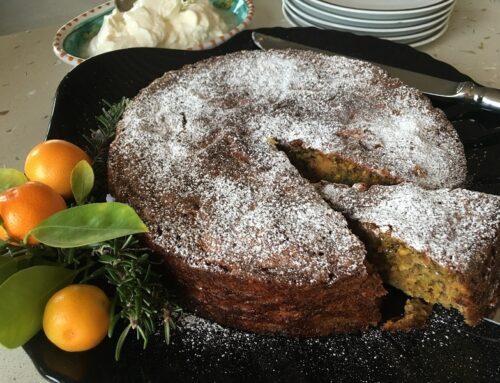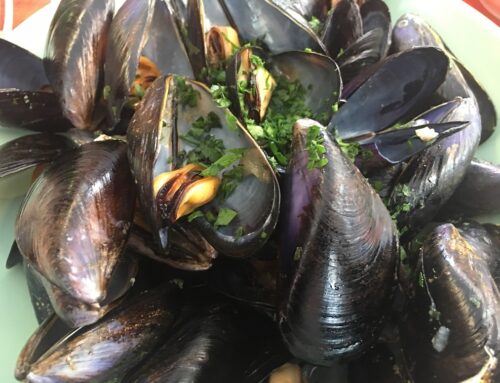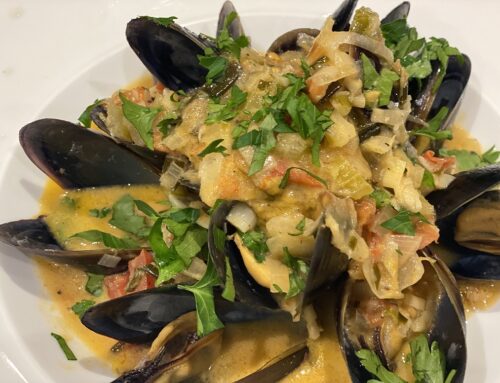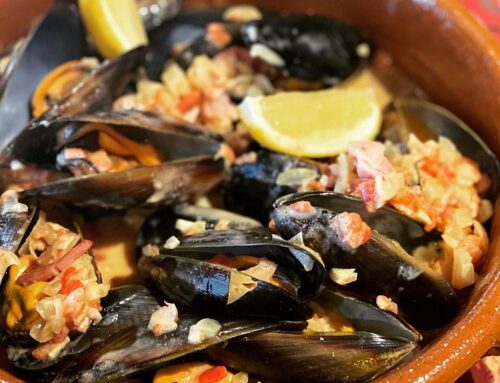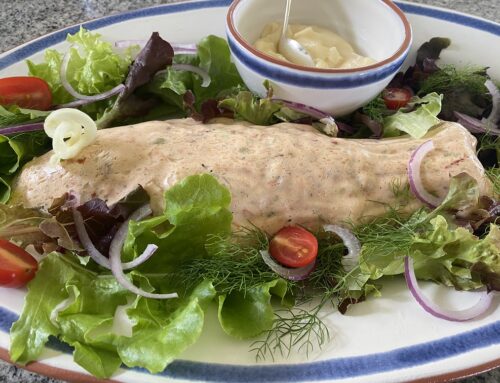Some mussels you buy are cultivated in protected areas of the sea bed, or grown on poles, fixed in clean saltwater. Others, because of their habitat, are often sandy and need to be scrubbed; mussels also ingest sand and grit as they feed.
Live mussels must be bought very fresh. Kept in a moist, cool environment, mussels will live out of water for between 8 – 12 days, depending on the season. They do this by gaping open and breathing. I store mine in a large plastic container, without the lid, in the refrigerator.
Scrub them clean and remove any barnacles and sand under cold, running water, using a stiff brush.
Pull off the weed-like ‘beard’ from the shell. Discard any mussels that are broken or that gape open and refuse to close when you tap them sharply and any that float. If a mussel is alive it will close when handled.
If the mussels are to be cooked in a liquid that can be strained, preliminary purging is not necessary. If the mussels are to be cooked directly in the sauce, they should be purged. Fortunately, most mussels we buy these days do not need this purging. If you collect them from the water, they will need to be purged.
Ways to purge the mussels of sand and grit:
- place the mussels in a large bowl of clean, cold, salted water, sprinkle with a handful of oats and set aside for a few hours. The mussels will feed on the oats and expel any grit they contain
- soak mussels for 2 – 3 hours, in salted water, one handful for each litre, changing the water 3 times.
The colour of mussel meat: in cooking classes, we are often asked why do some mussels have orange meat and others have white meat? The orange-tinted meats are actually mature females, while the ivory meats are males and immature females. While some ‘mussel aficionados’ maintain that mature females taste better, there’s no scientific evidence to back this up. I do think the orange-tinted meat is nicer as it is creamier, has more taste and looks inviting.
To cook mussels: the usual way to cook mussels is to heat 2 tablespoons of olive oil in a large pot and fry 2 finely sliced garlic cloves and 1 small shallot or onion until they colour. Add one cup of white wine, plus some water so the pot has about 2cm of liquid in the bottom, 6 black peppercorns and 4 parsley stalks; turn up the heat, and when very hot and boiling add the mussels.
It is best to remove the mussels as they open, otherwise, you risk overcooking them. Put the lid on the pot and shake it vigorously; after a minute or two of cooking, remove any mussels that have opened; cover again and keep shaking the pot and repeat removing the cooked mussels. After 5 minutes or so, discard any mussels that have not opened. Strain the cooking juices through a fine sieve, strainer or some muslin cloth and reserve this precious mussel liquor to use in a sauce.
A few general hints about mussels:
Don’t add salt when cooking
The best liquids for cooking mussels – red or white wine, Pernod, sherry or beer or water and mixture with water
Best beverages for drinking with mussels – white wine, Riesling especially, beer, pinot noir or green tea.
Herbs that love mussels – parsley, basil, tarragon, oregano, coriander and thyme
Natural flavour partners – garlic, onion, eschallots, tomatoes, capsicum, olives, butter, cream, lemon, lime
Stronger flavours that go well – chilli, lemongrass, ginger, cumin, fennel, saffron and pepper
Don’t cook for longer than 5 mins – they’ll be tough!
Don’t eat any that don’t smell “sea sweet”
Mussels are high in protein and heart-healthy omega-3 fatty acids; they are relatively low in calories and fat and have excellent nutritional value.
Mussels attach themselves to the rocks or ropes by way of byssal thread or beard.
- Cooked and out of their shells
- Spanish paella
- Mussel and vegetable soup
- Pumpkin, mussel and saffron soup







